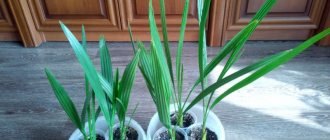Green, juicy grass for cats is a complete, affordable food in a pet’s diet. Young shoots contain the vitamins, minerals and fiber necessary for your pet. Planting grass is not difficult: in summer - on a summer cottage, in winter - on a windowsill. Having at your disposal the usual seeds of any cereal and a suitable container, you can provide your cat with fresh herbs, even without sowing them in the ground, at any time of the year.
Self-grown grass is a good alternative to indoor and garden flowers, most of which are dangerous to your pet’s health.
Benefits and harms
The beneficial substances contained in the herb have a beneficial effect on the health of the pet, namely:
Normal hematopoiesis in an animal occurs thanks to chlorophyll.
- Fiber improves digestion and cleanses the stomach of undigested food particles through the gag reflex.
- Vitamins and microelements strengthen the pet's immunity.
- Chlorophyll has a positive effect on the brain, supplies the body with oxygen, and participates in the process of hematopoiesis.
For improved intestinal function, including loosening stools, veterinarians recommend giving your pet sprouted seeds, and narrow blades of grass for strengthening. Grass can cause harm to your pet if the cat has eaten greens treated with herbicides. Domestic cats that are not outdoors and deprived of the opportunity to eat grass can encroach on potted indoor plants, most of which contain toxins that are dangerous to the animal.
5 plants you can grow on your cat's windowsill
Modern residents of megacities can rarely afford to let their cat outside, and in this case the animal’s risk of contracting an infection or injury is quite high, because our yards bear little resemblance to an environmentally friendly and convenient place for cats to walk. Meanwhile, spending time in the fresh air for animals is extremely beneficial for health, just like getting healthy greens as food supplements. Let's talk about 5 plants that you can grow for your cat on your windowsill.
Can you grow it at home?
To grow your own grass, you need cereal seeds, a suitable container and soil. There is a way to grow grass at home without soil. You can buy different types of grass seeds for cats at a pet store or regular grain at the farmer's market. 2-3 glasses of cereal grains are enough to provide your pet with vitamin greens for the whole season. Lush grass grows quickly under greenhouse conditions, but you need to ensure that the greens do not dry out ahead of time by moistening and spraying the soil. It is good to sow the seeds in several containers at once with an interval of 3-4 days, so that while the cat eats the first harvest, new shoots will grow in the second tray. If it is impossible to grow grass at home, you can buy ready-made greens without chemical additives, the name of which is “Grass for Cats” from the Titbit brand. There are step-by-step instructions for the fortified food. The disadvantage is the high price.
Valerian
Valerian is known to us all as an excellent sedative for people. It perfectly relieves tension and helps you relax before an important event or during a period of stress. Grass has the opposite effect on cats. Valerian stimulates metabolic processes in the body of cats, accelerates the blood, accelerates the rhythm of cardiac activity - in a word, invigorates. You should definitely try the effect of valerian on passive and phlegmatic animals, whose activity will noticeably increase due to the effect of essential oils contained in valerian. They will become more active and playful.
What kind of grass do you need?
Fluffies can eat lemon balm.
Cats can be given plants such as:
- Melissa;
- cat mint;
- thyme;
- valerian;
- oats;
- wheat;
- rye;
- barley.
Valerian, mint, lemon balm, thyme, lemongrass excite your pet or, conversely, calm it down. Such herbs are more attractive to animals due to their smell. Cats prefer to eat cereals. Sprouts of fresh grass in winter are very useful. This is the best vitamin supplement for the animal’s excellent well-being. Outdoor cats eat a grass called sow thistle, known as weed. But it has medicinal properties that have a beneficial effect on the health of the pet. An animal with fur of any color, be it gray, red, black and white, outdoor or indoor, needs fresh greens.
The most favorite herb for furry pets is sprouted oats. The young cereal is rich in folic acid, carotene, potassium, magnesium, silicon, and is therefore recommended by veterinarians for inclusion in the diet of a pregnant cat and a growing kitten.
Cat mint
Catnip is a favorite among cat plants. She is adored by cats all over the world, and, it turns out, for good reason. The plant has a beneficial effect on the animal’s nervous system, relaxing and relieving the cat from stress and nervousness. In addition, warm mint compresses help well with skin manifestations of various dermatoses and rashes on the animal’s skin - it eliminates itching and prevents cats from scratching themselves to the point of serious damage.
How to plant?
Growing seeds without soil
During the growing period, seedlings should be covered with gauze.
If you don’t have soil at hand, you can germinate oats for your cat using 2 plastic plates of different sizes and cotton wool. The yield with this method of germination is lower than when sowing seeds in the ground. After your pet eats the greens, they need to be re-sowed. The procedure for planting grains without a substrate is as follows:
- Make holes in a small plate to get rid of excess water.
- Moisten the cotton wool and spread it along the bottom of the holed container.
- Place the smaller plate on top of the larger one.
- Place the grains on moistened cotton wool.
- Cover the sown seeds with gauze.
- Wrap both plates in film and place on the windowsill.
- After seed germination, remove the polyethylene.
- Water the young grass little by little with clean water 1-2 r. in a day.
Method of planting in the ground
If soil was used to germinate grains, then the owner of the fluffy will be able to reap several harvests.
In another way, oat grass is planted using garden soil, substrate or soil for flowers. You can sprout greens in a pot, but to ensure stability, it is better to take a container with a wide base and sides up to 5 cm. Grass for cats grown in the ground is removed more than once. You can plant oats for cats in the ground like this:
- Pre-soak the grains in water for 1 hour.
- Pour soil into the prepared container.
- Moisten the soil base.
- Spread the seeds on a moistened substrate.
- Sprinkle a layer of earth no more than 1-2 cm on top.
- Add water.
- Stretch the film on top to create a greenhouse effect.
- Leave the mini-garden for 3 days at the optimal temperature for germination, 24-25°C, during which time the seeds should germinate.
- Remove the polyethylene after 4 days and place the container on the windowsill.
- After a week, young green shoots can be offered to your beloved pet.
Cat Grass (cat grass)
Virtually no maintenance: just plant the seeds, water occasionally, and your cat is provided with fresh grass at any time of the year.
Weed for cats helps cleanse the stomach of hair, and also helps keep ornamental plants in the apartment intact.
What herbs should a cat not eat?
After eating ivy, your pet will simply become poisoned.
Indoor flowers are dangerous for cats, most of which contain poisonous juice. Especially harmful are philodendron, dieffenbachia, alocasia, monstera, ficus, azalea, caladium, spurge, croton, oleander, adenium, cyclamen, delphinium, ivy, and chrysanthemum. Garden flowers such as lilies, gladioli, tulips, hyacinths, lilacs, pansies, carnations, snowdrops, and primroses are harmful. If a cat eats indoor plants, he is in danger. Once inside, a small piece of a poisonous plant can seriously harm a pet’s health, for example, cause a burn to the mucous membranes, vomiting, diarrhea, provoke nervous disorders, impair coordination, cause kidney failure, heart problems, lead to loss of vision if toxic juice gets into the eyes, possible cases of death. At the first signs of poisoning, you need to provide first aid to the animal and immediately contact a veterinarian.
To protect your pet from dangerous plants, you should not keep them in the house or prevent the animal from accessing flower pots and vases with bouquets. Citrus peels, which cats really dislike, are suitable for this purpose. It is placed near dangerous plants. Also, cats do not like rue, onions, and wormwood.
Lemongrass
Lemongrass, or Cymbopogon, belongs to plants of the Poaceae (poagrass) family, it is also called “lemongrass”, “lemongrass”, “lemongrass”, “citronella”, “shuttlebeard”. Evergreen perennial. As a wild herb, it grows in the tropics or subtropics. If you can find seeds or a rhizome that can be divided (or a stem that can be cut), be sure to get this plant! It does not touch the roots of other plants, it grows compactly, so it can be planted on borders, even in greenhouses.
It is a plant loved by felines and humans alike. You'll love the citrus scent, plus it repels mosquitoes and flies and can be used in cooking. And cats love him too! Just don't let them eat too
much as it may cause stomach upset.
Features of cultivation
It is not difficult to germinate oats at home because they sprout quickly. Cats like oats and contain beneficial substances.
How to grow oats for a cat so that it is constantly available to the animal? You will have to plant often, 3-4 times a month. But if you take a larger container, you can get by with 2-3 plantings.
You need to choose dishes for growing that are not very high, 5-6 cm is quite suitable. Its size can be different, the main thing is that it fits on the windowsill and it is convenient for the cat to eat from it.
As mentioned earlier, it is better to soak the grains in water for several hours before planting. This will ensure rapid germination, since it is easier for the sprout to hatch through the swollen shells.
After planting, the container is covered with film to ensure a greenhouse effect. When the right temperature approaches, the seeds will begin to germinate. If the sprouts have already sprouted, it is better to remove the film so that the plants can breathe, or you need to ventilate it periodically.
The customer is satisfied
It is better to purchase ready-made soil and vermiculite, since there are no pathogens there. There may be helminth eggs and other parasites in the soil from the site.
Lemon thyme
Instead of regular thyme (or in addition to it), plant lemon thyme, it is nice to add to tea. The leaves smell like our favorite yellow citrus fruits, lemons
, plus this plant grows easily and quickly.
Perennial, fragrant, unpretentious plant.
Growing mint on a windowsill has several other important advantages - it purifies the air and promotes the death of pathogenic bacteria, which is very important in winter.











